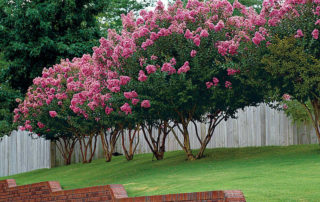How To Properly Care For Crape Myrtle’s
Topping trees is almost always wrong and harmful, but when it comes to doing this to the lovely crape myrtle, it's referred to as 'Crape Murder'. This practice is done by home owners and some landscapers alike, most likely due to misinformation and seeing their peers doing this practice as well. A lot of pruning efforts are culture based and not based on the science of horticulture. While the name implies that the tree will die from this act, it's a very resilient species. What this practice actually does is to keep the tree from reaching it's beautiful potential. When pruned properly, the Crape Myrtle has a vase shape that accentuates it's beautiful blooms and satiny bark. It's one of the South's most versatile landscaping trees. The most common reason for pruning these hearty trees is that they have gotten too tall for their space. In that instance, it's better to replace the trees with plants that fit the space better and transplant the crape myrtle to a better area where they can grow and shine. To properly prune these 'lilacs of the south' follow these simple steps: Remove the suckers from the bottom of the tree. Remove broken, crossed or diseased limbs. If two limbs are crossed, remove the weaker of the two. Prune just the tips of the branches to remove the old blooms. When blooms are removed another blooming may occur. Thin out the small, twiggy growth to allow air to circulate in the canopy of the tree. If a previous landscaper has committed this crime, there are measures that can be taken to return the tree to it's beautiful potential. It will take years but can be done by cutting the tree back within one to two inches of the ground. When new shoots emerge, select 3 to 5 of the strongest branches on each trunk and remove the others. After 3 - 5 years of growth the tree will be back to it's lovely shape with branches full of blooms. Whether in Memphis, Nashville, Little Rock or Jackson the crape myrtle is a staple of landscape design.

